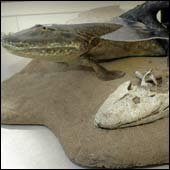Scientists reported discovering an evolutionary "missing link" between fish and land animals
Scientists reported discovering an evolutionary "missing link" between fish and land animals -- an ancient, river-dwelling predator with arm joints in its fins, an alligator-like head and ribs heavy enough to support its body on dry land.

Researchers found several fossils between four and nine feet long. The creature was a fish -- with scales, fins and gills -- but it moved its head independently of its body, could drag itself along on land as today's seals do, and may have walked, although the research team did not find fossil hindquarters to test that hypothesis.
The discovery provides the best evidence yet that fish emerged from the oceans and rivers of the early Earth between 380 million and 360 million years ago and evolved into terrestrial vertebrates beginning with amphibians and reptiles, and ending up with mammals and, ultimately, humans, reports Washington Post.
According to The Register, Daeschler, one of the team who made the discovery said: “This find is a dream come true.” The group named the fish after a local native name for a large fish that lives in the shallows.
Tiktaalik's fins were on the way to becoming fully-fledged limbs. The bones are adapted to flex so that it could prop itself up on land. Natural History Museum paleontologist Andrew Miller explained the significance: “It is a stepping-stone in the water-land transition showing us a permutation of features not seen before, notably the combination of lobe-fins with the beginnings of a neck.”
The predator's gills were still fully operational. The researchers interpret this to mean it still spent most of its time sub-aqua.
The animal, Tiktaalik roseae, lived about 375 million years ago, spanning the period between a fish called Panderichthys (385 million years ago) and tetrapods known as Acanthostega and Ichthyostega (365 million years ago).
The team discovered several well-preserved fossil specimens, ranging from 4 to 9 feet long from nose to the estimated end of the tail.
"If you look at joints of limbs, you can tell that the thing could perform a fish version of a push-up," Shubin told LiveScience. "It could bend its elbow and flex its wrist. It was certainly capable of supporting its body underwater, in the shallows, or in mudflats with its limbs."
The somewhat awkward animal probably didn't walk, since it likely couldn't rotate its shoulders. Instead it might have dragged itself along on land.
"It could either push itself straight up and down or pull itself forward," Shubin said. "It more likely flopped around like a seal rather than walked like a horse."
The longer snout suggests Tiktaalik bit at prey like a crocodile, rather than sucking on it like a fish, informs FOX News.
O.Ch.
Subscribe to Pravda.Ru Telegram channel, Facebook, RSS!




